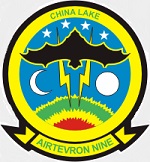Hobby Master HA6207 US Navy Lockheed-Martin F-35C Lightning II Joint Strike Fighter - 168842, VX-9 "Vampires", Naval Air Weapons Station China Lake, California, 2018 [Low-Vis Scheme] (1:72 Scale)
"The F-35 program executive officer, has stated that the 'F-35 enjoys a significant Combat Loss Exchange Ratio advantage over the current and future air-to-air threats, to include Sukhois, which are currently being flown by the Russian, Indian, and Chinese Air Forces.'"
- Maj Gen Charles R. Davis, USAF, the F-35 program executive officer
 The Lockheed Martin F-35 Lightning II is a fifth-generation, single-seat, single-engine, stealth-capable military strike fighter, a multirole aircraft that can perform close air support, tactical bombing, and air superiority fighter missions. The F-35 has three different models; one is the conventional takeoff and landing variant, the second is short takeoff and vertical-landing variant, and the third is a carrier-based variant.
The Lockheed Martin F-35 Lightning II is a fifth-generation, single-seat, single-engine, stealth-capable military strike fighter, a multirole aircraft that can perform close air support, tactical bombing, and air superiority fighter missions. The F-35 has three different models; one is the conventional takeoff and landing variant, the second is short takeoff and vertical-landing variant, and the third is a carrier-based variant.
The F-35 is descended from the X-35, the product of the Joint Strike Fighter (JSF) program. Its development is being principally funded by the United States, with the United Kingdom, and other partner governments providing additional funding. It is being designed and built by an aerospace industry team led by Lockheed Martin with Northrop Grumman and BAE Systems as major partners. Demonstrator aircraft flew in 2000, with the first flight on December 15th, 2006.
The F-35C combines this unique capability of operating from a carrier deck with the unmatched 5th Generation capabilities of stealth, fused sensors and reliability, making the F-35C the Navy?s future first-day-of-the-war strike fighter.
The Navy and Marines require an aircraft capable of overcoming a variety of threats - surface-to-air missiles, air-to-air missiles and tactical aircraft. By leveraging this potent combination of stealth, advanced jamming and threat system destruction, the F-35C enhances survivability and increases mission success rates.
The F-35C variant has larger wings and more robust landing gear than the other variants, making it suitable for catapult launches and fly-in arrestments aboard naval aircraft carriers. Its wingtips also fold to allow for more room on the carrier?s deck while deployed.
The F-35C also has the greatest internal fuel capacity of the three F-35 variants. The F-35C carries nearly 20,000 pounds of internal fuel for longer range and better persistence than any other fighter in a combat configuration. And, like the F-35B, the F-35C uses probe and drogue refueling. This allows the Navy to operate its carriers a safe distance from the threat while its fighters reach remote targets.
Pictured here is a 1:72 scale replica of a US Navy Lockheed-Martin F-35C Lightning II Joint Strike Fighter that was assigned to VX-9 "Vampires", then deployed to Naval Air Weapons Station China Lake, California, during 2018.
Sold Out!
Dimensions:
Wingspan: 7-1/4-inches
Length: 8-1/2-inches
Release Date: February 2023
 Historical Account: "Vampires" - Air Test and Evaluation Squadron Nine (AIRTEVRON NINE, VX-9, nicknamed The Vampires) is a United States Navy air test and evaluation squadron based at Naval Air Weapons Station China Lake, California. Using the tail code XE, the squadron operates numerous aircraft and helicopters of the United States Navy and United States Marine Corps.
Historical Account: "Vampires" - Air Test and Evaluation Squadron Nine (AIRTEVRON NINE, VX-9, nicknamed The Vampires) is a United States Navy air test and evaluation squadron based at Naval Air Weapons Station China Lake, California. Using the tail code XE, the squadron operates numerous aircraft and helicopters of the United States Navy and United States Marine Corps.
Today, VX-9 has approximately 61 officers, 290 enlisted personnel, and 25 aircraft at NAS China Lake including: the F/A-18E/F Super Hornet, EA-18G Growler, F/A-18C/D Hornet, UH-1Y Venom, AH-1W SuperCobra and AH-1Z Viper. Additionally, VX-9 performs operational test on the EA-6B Prowler and AV-8B Harrier II; however, these test assets are owned by VX-23 and VX-31, respectively.
Until the retirement of the F-14 Tomcat, the unit also had 4 F-14As, 3 F-14Bs and 4 F-14Ds at NAS Point Mugu. Although the Point Mugu detachment has ceased operations, a new VX-9 detachment has since been established at Edwards AFB, California for the F-35C Lightning II.
Typically, aircrews are qualified in more than one of these aircraft types which increases their versatility and provides a broader base of expertise that can be applied to each project. VX-9's mission has grown to include the operational evaluation of attack, fighter, and electronic warfare aircraft, weapons systems and equipment, and to develop tactical procedures for their employment.
As for chain of command, operationally, VX-9 reports to Commander, Operational Test and Evaluation Force (COMOPTEVFOR) and administratively to Commander, U.S. Naval Air Force, Pacific Fleet (COMNAVAIRPAC).


